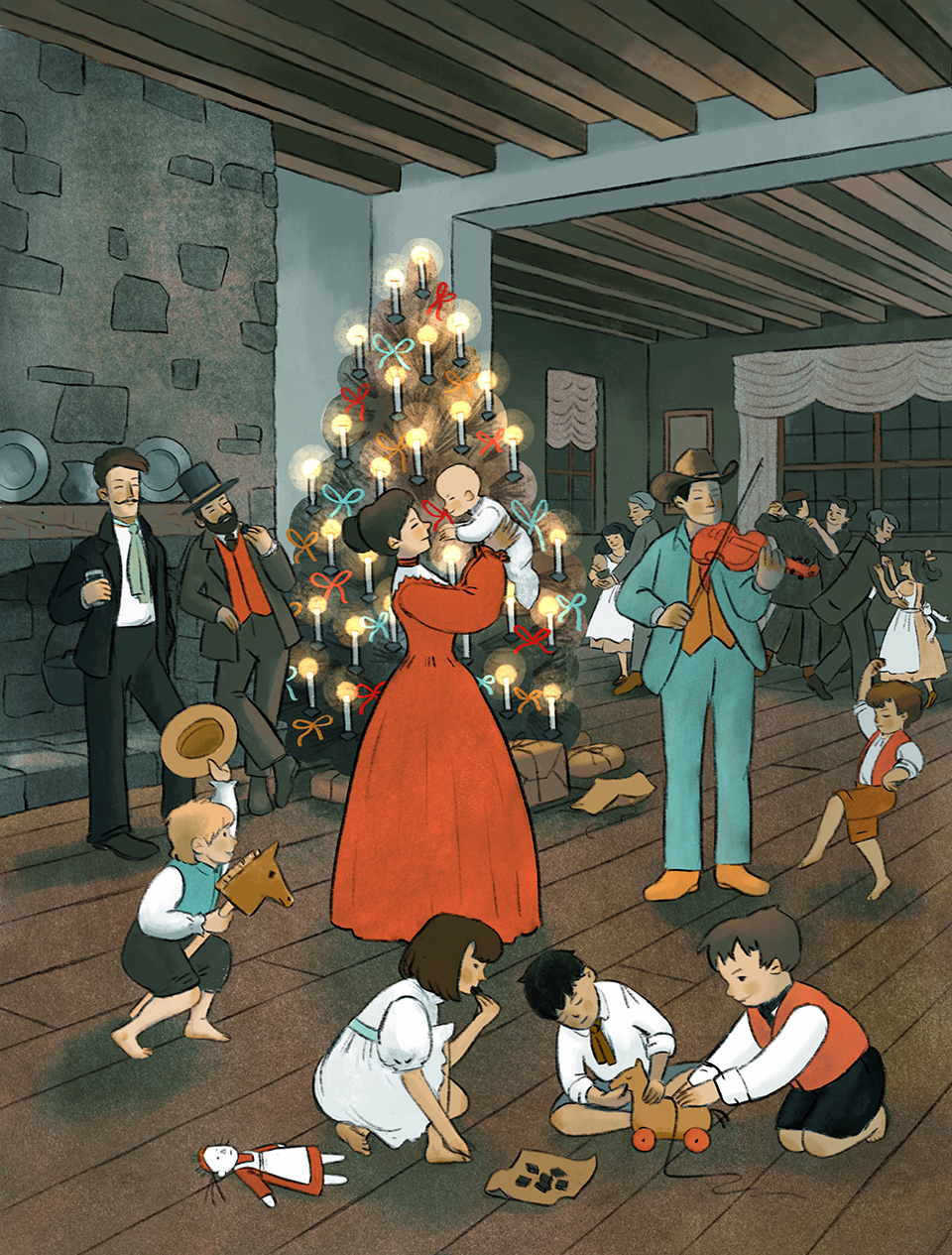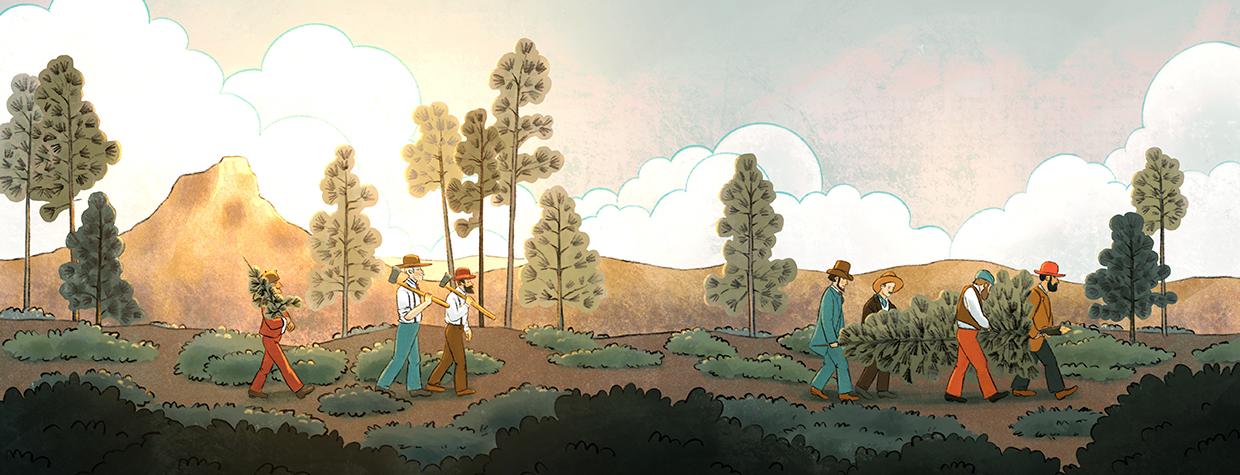The Territory of Arizona had been established; the first governor and his official family had braved the hardships of the hazardous journey from Fort Larned, Kansas, and arrived safely; the governor’s mansion had been built and the first Legislature had convened there. Prescott was taking pride in being the capital of the Territory.
Christmas was approaching, and, now that homes had been established, came thought of the holiday spirit.
A kindly German, Mr. I.N. Rodenburg, recalling the happy memories of his childhood at Christmastime, felt that these pioneers in their new homes should have something of the Yuletide joy. They would have a Christmas tree.
A committee was appointed, and the little town of Prescott was filled with humorous curiosity. Where were the toys and candies and other goodies to come from? Where were they to get colored candles and tinsel to bedeck a tree? And where were the children, with their shining eyes and merry laughter? A survey of the situation showed seven children and six others still young but grown tall.
Mr. Rodenburg, accompanied by six men, went into the woods and cut a beautiful fir tree.
A Christmas tree must have lights, and the stores did have tallow candles. These were cut in two and the candles tied to the branches with twine. Trunks were searched, and the women brought forth treasured bits of ribbon to give the tree a festive air.
The stores, where frijoles elbowed axle grease on the shelves, offered little in the way of luxuries: no bonbons, no candy of any sort; in fact, no toys and certainly no Christmas tree ornaments. But the committee was not to be discouraged. A sack of brown sugar was purchased, and a New Orleans man with a flair for cooking made three kinds of black-jack. That settled the candy question. The black-jack was put into manila paper bags, which were sealed with flour paste.
A Christmas tree must have lights, and the stores did have tallow candles. These were cut in two and the candles tied to the branches with twine. Trunks were searched, and the women brought forth treasured bits of ribbon to give the tree a festive air.
Toys? Surely they must have toys for the children. So, the men who were handy with pocketknives and tools were called upon, and there were toys.
Now the committee met its really serious problem: music. After many hours of searching, a fiddle was found, minus a string and a bit battered. The owner could play only one tune: The Arkansas Traveler. However, the committee hit upon a bright idea. He could play the tune halfway through, then repeat it with variations.
By early evening, the little home of the Rodenburgs was crowded. The Christmas tree and Christmas party were reality.
Many years later, Mr. Rodenburg, speaking of that first Christmas, said:
“Electric bulbs may glow in many colors from the Christmas trees of the present day. Trained voices may chant the melodies; diamonds may ornament the guests. Children may devour the gaily colored sweets that are run out by the ton, but that old black-jack was just as good — that old tree was just as handsome, and, above all, there was the devoted spirit around the Christmas tree of long, long ago that cannot be duplicated, because we did not mix the occasion then, as they do now, with discrimination and commercialism.”

Miss Sharlot Hall of Prescott, having gained much information from pioneers and old files, relates the story of another early Christmas celebration.
“Christmas Day and Christmas night the governor kept open house to all who came,” said Miss Hall, “and this included many men from the Lynx Creek mining camps and the placer mines. Sam Miller, who was the town hunter, furnished deer, antelope and wild turkey in great quantity, and a large beef from one of the ox trains was killed and divided among all the families. The meat was barbecued in a backyard. Mrs. Ehle and Mrs. Julius Sanders baked the cakes. There was a dance Christmas night, and everybody in the whole region attended and danced on the dirt floors ’til morning.
“By Christmas of 1865, the young wife of Secretary [Richard Cunningham] McCormick had arrived and become the first mistress of the mansion. Already she had made friends with the few families and with all the people in the little camp. She proposed and helped with a Christmas tree, which was set up in a front room of the governor’s house. Everyone was invited, and there were great numbers of homemade gifts.
“The women had been meeting at Mrs. Ehle’s home to make things: little pincushions and tiny handbags with drawstrings for the girls, and wristlets and scarves for the boys. And the new Mrs. McCormick divided her pretty wedding handkerchiefs among the women. Some years ago, Mrs. Ehle’s daughter showed me a pincushion from that tree.
“The women had baked dozens of little cakes to go in the bags, and in place of candy there was brown sugar in cakes, from Mexico. A very small amount of real candy came from San Francisco. This tree was celebrated on Christmas Eve. On Christmas night there was a big dance, and Sam Miller, in his buckskin hunting suit, danced with the new bride, who wore some of her wedding finery. It was a joke for a long while that young Miller, who danced beautifully even when he was an old man, quite took the ‘shine’ off the official family in their regulation suits.
“There had been rag dolls made for all the little girls and put on the tree the night before, and one woman told me how, as a child, she took her doll to the dance the next evening and danced with the grown men while hanging tightly onto her wonderful doll with one hand. There were so few women that the little girls were needed to make up the sets in the dances.”
The Christmas celebrations, meager as they were, were joyous occasions that contrasted sharply with the harsh everyday life on the frontier.

